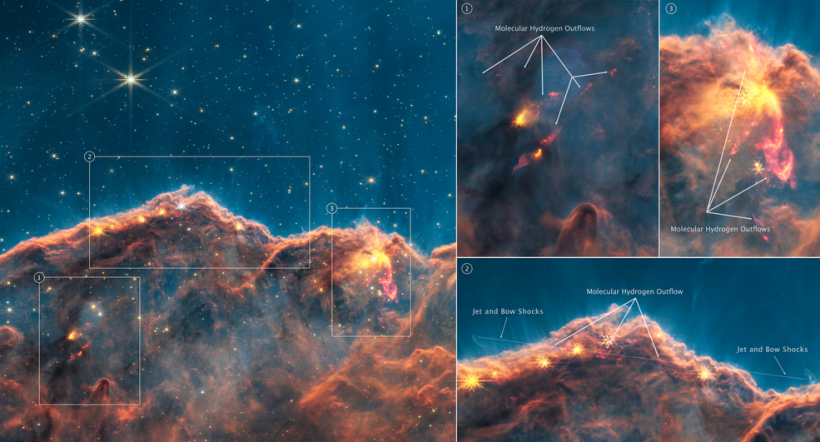A detailed examination of one of James Webb Space Telescope's early photos by researchers led to the discovery of several powerful jets and outflows from newborn stars that dust clouds had previously masked.
NASA said that the finding ushers in a new age of research into the formation of stars like our Sun and how radiation from adjacent large stars may impact the formation of planets.

The Cosmic Cliffs
The Cosmic Cliffs, an area at the edge of a large, gaseous cavity inside the star cluster NGC 3324, have long caught astronomers' attention as a hotspot for star creation.
Even though NGC 3324 has been extensively investigated by the Hubble Space Telescope, many aspects of star formation are still obscured at visible light wavelengths.
Since Webb is designed to identify jets and outflows observed exclusively in the infrared at high resolution, it is perfectly suited to extract these long-sought details.
By analyzing data from a certain wavelength of infrared light, astronomers recently identified two dozen previously unknown outflows from very young stars that are revealed by molecular hydrogen.
Webb observed a wide range of objects, from tiny fountains to gurgling behemoths that are light-years away from the generating stars. A large number of these protostars are about to transform into low-mass stars like the Sun.
Read also: NASA's James Webb Space Telescope Sees Shining Pearls, Diamonds in Previously Unseen Galaxies
Early-Star Formation Tracer
A crucial component in the creation of new stars, molecular hydrogen also serves as a superb early-star formation tracer. A portion of the material that young stars absorb from the gas and dust around them is typically also ejected back out again from their polar regions in jets and outflow, as per NASA.
The majority of earlier research on jets and outflows focused on nearer regions and more advanced objects that Hubble could already detect.
Webb's exceptional sensitivity enables views of farther-off locations, and its infrared optimization looks into the earlier stages of dust sampling.
NASA said that this opens a window into the environments similar to the birthplace of our solar system.
Since the star formation process takes millions of years and only lasts a few thousand to ten thousand years for each star, this early stage of star creation is particularly challenging to observe.
Astronomers are learning more about how busy these star-forming areas are, even over very short periods, as a result of examining the new Webb observations.
The scientists were able to determine the direction and speed of the jets by tracking their position about Hubble's archived data from 16 decades ago and the positions of known outflows in this region that Webb had previously seen.
The new findings were published in the Monthly Notices of the Royal Astronomical Society.
Related Article: NASA's James Webb Space Telescope Snaps a Chaotic, Disturbing Connection Between Two Galaxies









